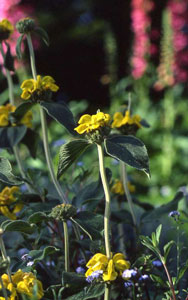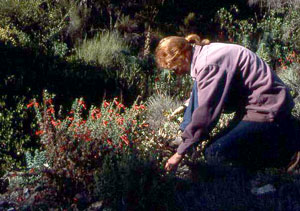Mixing the Horticultural Interlopers with the Natives
A drought-resistant landscape
Like most homes in my neighborhood, the area adjacent to the home is some form of landscaping, ornamental garden or food garden—pockets of alien plants in a sea of native trees, ferns, grasses, herbaceous perennials and shrubs. (Or European grasses.) When city folk first move up here, they plant their favorite rose, only to wake up within week or so to roses eaten back to stubs—flowers and thorns. Deer fences protect prized roses and countless other plants that would just be entrées for foraging deer. Those people who want an ornamental garden can’t easily fall back on native shrubs and trees, as many are eaten by the deer shortly after being planted. My theory is the plants are so pumped up with water and fertilizer at the garden nurseries that they offer a succulence to the deer. Also, a Ceanothes spp. (Summer Lilac—which is in no way related to what most of the country calls the aromatic lilac shrub) that thrives a mere 30 miles from my garden is quickly consumed by my herd of deer. It’s hard to remember that many plants were born then eaten or died before we came along to see the hardy and lucky survivors. It’s hard to pay $20 for a plant to watch it become deer fodder.
Ironically, most gardens outside the deer fence are not filled with native plants but with the exotics from other Mediterranean places around the world. The deer haven’t, yet, adjusted to their unique mix of tannin, alkaloids and other protective chemicals. More fascinating, some plants from foreign lands are more drought hardy than the local fauna.
One of the myths to crumble as I landscaped through the California drought of 1995-1997 was the idea that California native plants are superior in their drought-resistance. While certain California desert plants are among the world's most drought-hardy, they won't survive my 58-inch winter rains.
There are a handful of Mediterranean climates throughout the world besides California—the Mediterranean basin, of course, the middle elevations of the Chilean mountains, portions of South Africa, and parts of Australia. Most of these climates are cousins to our Californian Mediterranean ecosystem and droughts are more severe and the rainfall considerably more sparse in some of these places. Plants from these areas will adapt to many other aspects of the climate and soil in parts of California and still retain their superior drought-hardiness.
A virtually unrecognized article entitled, "A Trial of Drought Tolerance", in Pacific Horticulture magazine, discussed the observations of Barrie Coates of various plants installed during the drought of 1975 on a south-facing site in Santa Cruz county. The plants were irrigated during the first summer only. The study evaluated both the size and the condition of the plant relative to how it would look as a landscape plant after a summer without supplemental irrigation—in other words, sheer survival was not the objective. The unirrigated plant's ornamental appearance was an important criteria. According to Coates, "The California native plants were not generally the best performers in this hot, dry site. Some exotics from climates similar to that of the test site performed better than many of the natives. Of nine plants that performed best, six are native to the Mediterranean region and two are from Australia."
|
|
The "winners" of this small trial were, in the order of best ornamental value:
1. Numero uno - Pride-of-Madeira ( Echium fatuosum)

2 - Spanish lavender (Lavandula dentata)
3 - Jerusalem sage (Phlomis fruticosa)

4 - Rockrose (Cistus parviflorus)
5 - California fuchsia (Zauschneria californica latifolia, now labeled as Epilobium canum latifolium.)

6 - Peppermint tree (Agonis flexuosa)
7 - Sage-leaf rockrose (Cistus salvifolius)
8 - Hypericum (Hypericum coris)
9 - Tristania laurina
10 - Manzanita (Arctostaphylos 'Dr. Hurd')
Of this list, only the California fuschia and manzanita are native to California.
Coates concludes, "...it is more sensible to choose plants for their adaptability to the site than for their area of origin. Except in the hands of an enthusiast for California native plants, a drought tolerant planting will probably be more beautiful and satisfying if well-chosen exotics are included."
Water need not be a limiting factor in my landscape. Thoughtful and well-planned gardens can be beautiful and resistant to the vagaries of drought. A dry landscape need not be an ugly landscape. Unlike "dry" or "lite" beer, I don't have to settle for second-best, a drought-resistant landscape can have all the beauty, fragrance, color, and texture I’d ever want.
|

